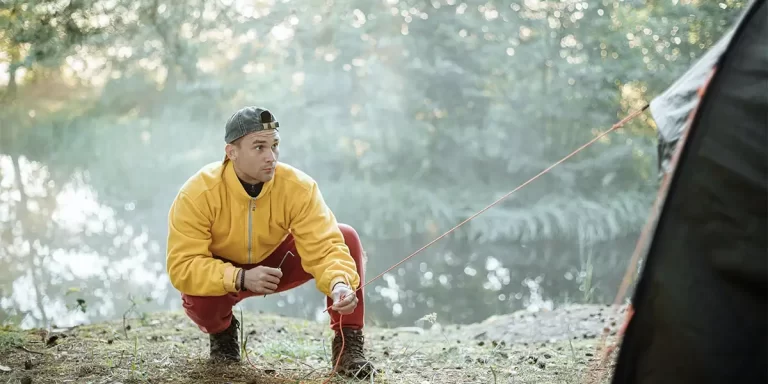

As an avid backpacker, you know that guy lines are an important part of setting up your tent or tarps while camping.
However, you may not be completely clear on when and how to use them effectively.
In this post, we’ll look at guy lines and discuss when it’s appropriate to use them as well as how to properly set them up.
When you’re out on an adventure, every little detail matters. That’s where guy lines come into play.
A tent guy line, which can also be called a guy cable, guyline, guy rope, or guy wire, is like a piece of string or rope that you use when camping. It helps to keep the tent walls in place or secure the rainfly (the cover) tightly to the ground.

Now that you know why guy lines matter and when to use them, let’s get practical: setting them up right. Don’t worry, it’s not complicated.
Step 1: Attaching to Your Tent
Locate the loops on your tent, often called “guy out loops.” These are your starting points. Tie each guy line securely to these loops using a simple knot.
Step 2: Adding Adjusters
Get your hands on guy line adjusters (or guy line tensioners). These little helpers make adjusting your guy lines a breeze.
Thread the cord through the adjuster’s holes: up through the first, down through the second, and back up through the third. This should form an ‘S’ shape.
To keep it in place, tie a strong knot at the end of the cord.

For smaller (diameter-wise) and shorter cords consider using lineloc’s.
Step 3: Anchoring to the Ground:
Loop the cord around the top of the stake and push it firmly into the ground at around a 45-degree angle.
Now that you’re equipped with the basics of guy lines, here are some pro tips to take your setup to the next level and ensure a hassle-free outdoor experience:
If you want to elevate your camping experience, check out our detailed guide on selecting the perfect campsite.
With your newfound expertise in guy lines, you’ve uncovered how these seemingly ordinary ropes can significantly enhance your camping experience.
Whether it’s windy, you want more tent space, or you’re stopping condensation, guy lines have got your back.
Guy lines should be taut, not overly tight, to avoid overtensioning that can damage the tent fabric. Maintaining proper tension helps stabilize tents, promote ventilation, and prevent flapping in windy conditions, ensuring a better camping experience.
Guy lines should generally be around 6 to 8 feet in length. This allows you to create a 45-degree angle from the tent to the anchor point when the line is taut. This angle provides optimal tension for stability, preventing the tent from sagging or swaying in the wind. Keep in mind that specific conditions and tent designs may slightly alter this estimate, so it’s a good practice to have a bit of extra length available for adjustments.